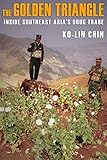The Golden Triangle : Inside Southeast Asia's Drug Trade / Ko-lin Chin.
Material type: TextPublisher: Ithaca, NY : Cornell University Press, [2010]Copyright date: ©2011Description: 1 online resource (296 p.) : 12 tables, 2 mapsContent type:
TextPublisher: Ithaca, NY : Cornell University Press, [2010]Copyright date: ©2011Description: 1 online resource (296 p.) : 12 tables, 2 mapsContent type: - 9780801458439
- 363.4509591 22
- HV5840
- online - DeGruyter
| Item type | Current library | Call number | URL | Status | Notes | Barcode | |
|---|---|---|---|---|---|---|---|
 eBook
eBook
|
Biblioteca "Angelicum" Pont. Univ. S.Tommaso d'Aquino Nuvola online | online - DeGruyter (Browse shelf(Opens below)) | Online access | Not for loan (Accesso limitato) | Accesso per gli utenti autorizzati / Access for authorized users | (dgr)9780801458439 |
Browsing Biblioteca "Angelicum" Pont. Univ. S.Tommaso d'Aquino shelves, Shelving location: Nuvola online Close shelf browser (Hides shelf browser)

|

|

|

|

|

|

|
||
| online - DeGruyter My Word! : Plagiarism and College Culture / | online - DeGruyter So Great a Light, So Great a Smoke : The Beguin Heretics of Languedoc / | online - DeGruyter My Father and I : The Marais and the Queerness of Community / | online - DeGruyter The Golden Triangle : Inside Southeast Asia's Drug Trade / | online - DeGruyter Workplace Flexibility : Realigning 20th-Century Jobs for a 21st-Century Workforce / | online - DeGruyter Organizing at the Margins : The Symbolic Politics of Labor in South Korea and the United States / | online - DeGruyter Building More Effective Unions / |
Frontmatter -- Contents -- Acknowledgments -- Introduction: Into the Thick of It -- 1. The Golden Triangle and Burma -- 2. The Wa -- 3. The Opium Trade -- 4. Heroin Production and Trafficking -- 5. The Methamphetamine Business -- 6. Drug Use -- 7. Drug Control -- 8. The Business and Politics of Drugs -- Appendix: Names in Pinyin Romanization and Other Spellings -- Notes -- Bibliography -- Index
restricted access online access with authorization star
http://purl.org/coar/access_right/c_16ec
The Golden Triangle region that joins Burma, Thailand, and Laos is one of the global centers of opiate and methamphetamine production. Opportunistic Chinese businessmen and leaders of various armed groups are largely responsible for the manufacture of these drugs. The region is defined by the apparently conflicting parallel strands of criminality and efforts at state building, a tension embodied by a group of individuals who are simultaneously local political leaders, drug entrepreneurs, and members of heavily armed militias.Ko-lin Chin, a Chinese American criminologist who was born and raised in Burma, conducted five hundred face-to-face interviews with poppy growers, drug dealers, drug users, armed group leaders, law-enforcement authorities, and other key informants in Burma, Thailand, and China. The Golden Triangle provides a lively portrait of a region in constant transition, a place where political development is intimately linked to the vagaries of the global market in illicit drugs.Chin explains the nature of opium growing, heroin and methamphetamine production, drug sales, and drug use. He also shows how government officials who live in these areas view themselves not as drug kingpins, but as people who are carrying the responsibility for local economic development on their shoulders.
Mode of access: Internet via World Wide Web.
In English.
Description based on online resource; title from PDF title page (publisher's Web site, viewed 26. Apr 2024)


